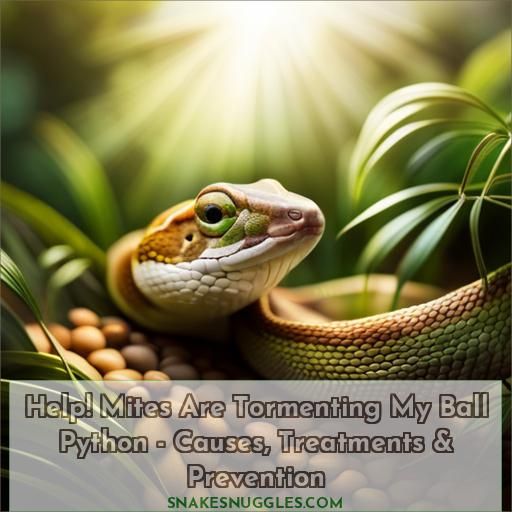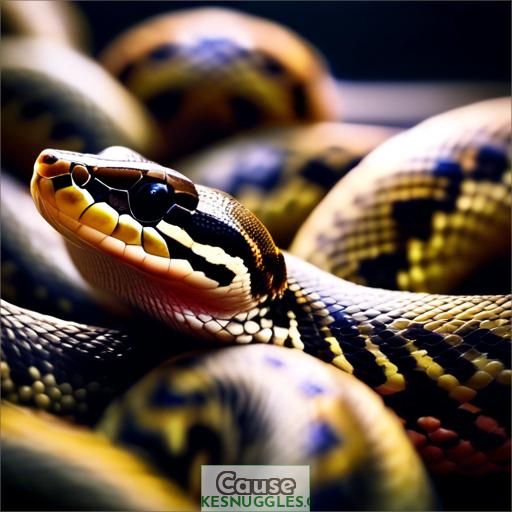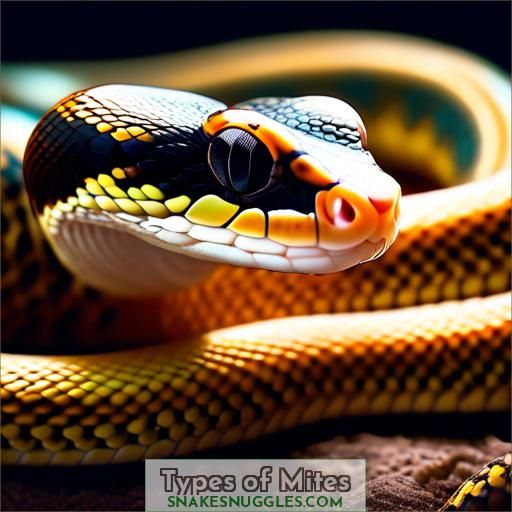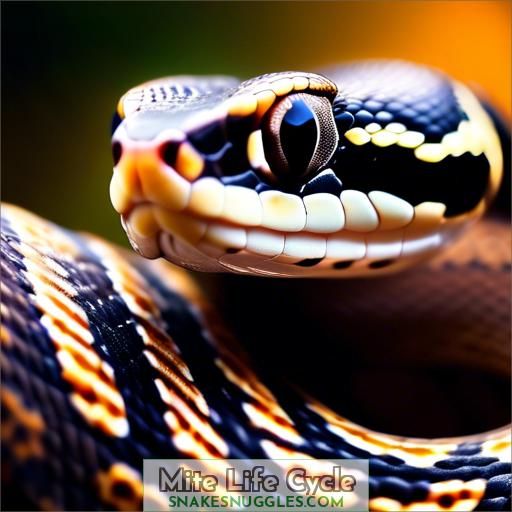This site is supported by our readers. We may earn a commission, at no cost to you, if you purchase through links.
Your ball python‘s peculiar behavior and those annoying black specks are tell-tale signs of a mite infestation.
These tiny parasites spread quickly, causing damage to your beloved pet’s health.
Promptly identify the culprit – whether snake mites, reptile mites, or other mite species targeting your ball python.
A detailed treatment plan using specialized mite sprays and strict hygiene practices is essential.
But don’t worry; with perseverance, you can eliminate these pests and prevent future infestations, ensuring your snake’s thriving well-being.
Explore deeper to uncover extensive mite management strategies designed specifically for ball python owners.
Table Of Contents
Key Takeaways
- Mite infestations in ball pythons can be challenging to detect due to their small size, but symptoms such as swelling around the eyes or face, sores or lesions on the skin, excessive scratching or rubbing against surfaces, prolonged soaking, and loss of appetite can help identify an infestation.
- Poor hygiene, contamination from infected reptiles, and wild-caught reptiles are common causes of mite infestations in ball pythons.
- Effective treatment for mite infestations involves using specialized mite sprays and strict hygiene practices, such as diluting Nix cream in distilled water and spraying the solution on the snake and enclosure, or using Hot Shot No-Pest Strips for vapor treatments.
- Preventive measures for mite infestations include adhering to rigorous quarantine protocols for new pets, using paper substrate until mites are eradicated, removing the water bowl during treatment, and implementing chemical or vapor treatments as needed.
Symptoms
You’ll recognize a mite infestation on your ball python through behavioral changes like excessive soaking, rubbing against surfaces, and lethargy, as well as physical symptoms like tiny black dots around the eyes, ears, and vent area, and loss of appetite. Carefully inspecting your snake and enclosure for these tell-tale signs is essential for early detection and effective treatment.
Recognizing Mite Infestation
Recognizing Mite Infestation (Symptoms):
Mite infestation in ball pythons can be challenging to detect due to their small size. However, there are several signs that can help you identify a mite infestation:
- Swelling around the eyes or face: Mites can cause irritation and inflammation, leading to swelling in these areas.
- Sores or lesions on the skin: Mites feed on the blood of their host, which can result in sores or lesions on the skin.
- Excessive scratching or rubbing against surfaces: Mites can cause discomfort and itchiness, leading to excessive scratching or rubbing against surfaces.
- Prolonged soaking: Ball pythons may soak excessively in their water bowl to try and drown the mites.
- Loss of appetite: Mites can cause stress and discomfort, leading to a loss of appetite in ball pythons.
If you notice any of these symptoms, it’s essential to take immediate action to prevent the infestation from spreading further.
Behavioral Changes Observed
When your ball python is infested with mites, it may exhibit several behavioral changes. These changes are a result of the discomfort and stress caused by the parasites. Here are some common behavioral changes to look out for:
- Rubbing: Your snake may rub its body against objects in its enclosure, trying to alleviate the itching caused by the mites.
- Lethargy: Mites can cause your snake to become lethargic and inactive, as the energy it would normally use to hunt and move is diverted to combating the parasites.
- Prolonged soaking: In an attempt to drown the mites, your snake may spend more time than usual in its water bowl, soaking for extended periods.
- Loss of appetite: The stress and discomfort caused by the mites can lead to a loss of appetite, making it difficult for your snake to maintain its health.
These behavioral changes are often accompanied by physical symptoms, such as tiny black dots around the eyes, ears, and vent, which are the mites themselves. It’s crucial to address these behavioral changes promptly, as they can indicate a more severe infestation that may require professional veterinary treatment.
Identifying Physical Symptoms
Recognizing physical symptoms is vital for detecting mite infestations in your Ball Python. Rubbing, sluggishness, prolonged soaking, loss of hunger, and tiny black dots around eyes, ears, and vent are common signs. Mite structure, anatomy, and behavior can help differentiate between species, while mite reproduction and feeding patterns can indicate the severity of the infestation.
Cause
After discovering the subtle signs of mite infestation in your ball python, it’s essential to identify the perpetrators behind this annoying issue. Mites don’t just magically appear; they’re the unwelcome visitors who gatecrash the party due to specific factors. Let’s delve into the causes:
- Poor Hygiene: An unhygienic habitat is a mite’s playground.
- Contamination from Infected Reptiles: Mite transmission can happen when your python socializes with a newly infected friend.
- Wild-Caught Reptiles: These explorers often bring back more than just stories from the wild, emphasizing the importance of quarantine.
Treatment
If your Ball Python has mites, don’t panic! You can effectively treat and prevent these pesky parasites with the right approach. Here’s a step-by-step guide on how to use Nix treatment, dilute the solution, and apply it to your snake and its enclosure:
- Purchase Nix and Distilled Water: You’ll need a 56g (59ml) bottle of Nix and a 4L (1 gallon) jug of distilled water.
- Mix the Nix Solution: Pour the Nix cream into the jug of distilled water. Nix is a thick cream, so it may take a few minutes to transfer it all into the jug. Shake the jug until the Nix cream is evenly distributed throughout the water.
- Dilute the Nix Solution: Mix 1 part Nix with 68 parts distilled water to create a diluted solution.
- Prepare a Spray Bottle: Use a clean spray bottle that has never been used or at least one that has never contained harsh chemicals. Rinse it thoroughly before use.
- Spray the Snake: Remove the snake from its enclosure and place it in a Rubbermaid container. Spray the snake liberally with the Nix solution, making sure to cover its head, eyes, and heat pits.
- Clean the Enclosure: Remove all substrate from the terrarium and throw it away. Spray the entire enclosure, inside and out, including all cage furniture and the glass viewing area. Focus on corners and crevices, as these are where mites and their eggs often hide.
- Replace Substrate: Use paper or paper towel as a temporary substrate until you’re sure the mites are gone.
- Repeat the Treatment: After 7 days, repeat the treatment. Then, wait another 7 days and repeat again for a total of 3 treatments.
- Remove Water Bowl: During the treatment, remove the water bowl from the enclosure.
- Quarantine New Reptiles: To prevent future infestations, quarantine new reptiles for 2-3 months in a separate room or enclosure.
Prevention
To avert mite infestations in your Ball Python, it’s paramount to adhere to rigorous quarantine protocols for new pets.
Presume they’ve mites and take preemptive actions.
Utilize paper substrate until mites are eradicated, and remove the water bowl during treatment.
Replace the substrate with paper after cleaning.
For chemical treatments, dilute Nix cream in distilled water and spray the solution on the snake and enclosure.
For vapor treatments, employ Hot Shot No-Pest Strips, suspending them in the snake room or placing them in sealed containers within the enclosure.
Bear in mind to ventilate the room post-treatment.
By implementing these preventative measures, you’ll guarantee a healthier, mite-free environment for your treasured Ball Python.
Types of Mites
Regarding mite identification, familiarity with your opponent is crucial. These diminutive creatures can devastate your ball python’s well-being, so let’s delve into the distinguishing mite traits:
- Mite Species: Discern between prevalent perpetrators like Ophionyssus natricis and Ophionyssus acertinus.
- Color Clues: Observe for red, black, or orange specks, an unmistakable indication of these unwelcome visitors.
- Size Matters: Although minute, mites are discernible as tiny dots traversing your snake’s skin.
- Mite Biology: Comprehending their shape and coloration post-feeding can facilitate identification.
- Behavioral Giveaway: Mites often congregate near the head and vent, so scrutinize these areas.
Remain vigilant, and you’ll emerge as the mite vanquisher your serpentine companion requires!
Mite Life Cycle
The life cycle of snake mites, also known as Ophionyssus natricis, is a five-stage process that involves eggs, larvae, protonymphs, deutonymphs, and adults.
- Eggs: The eggs are laid on the skin of the snake or in dark, humid areas within the enclosure. They’re white in color and sticky, and hatch within one to four days depending on the environmental conditions.
- Larva: After hatching, the larvae are pale white and non-feeding. They’re capable of walking but tend to move very little distance from the eggs. Larvae require at least 75% humidity to progress to the next stage.
- Protonymph: This stage is mobile and requires a blood meal from the snake to metamorphose into the next stage. Protonymphs are attracted to the smell of snakes and can be found on scale surfaces and head plates. They’re pale ivory or yellowish in color when unfed, and dark red when engorged with blood.
- Deutonymph: This stage is soft-bodied, dark red or black in color, and non-feeding. Deutonymphs are usually found in dark, humid areas away from the snake. They shed within 12 to 24 hours to become adults.
- Adult: Adult mites are smaller than adult females and can range in color from dark yellowish-brown to dark red or black depending on their feeding status. Females can lay a dozen or two eggs at a time, and the entire life cycle can be completed in 13 to 19 days at ideal temperatures.
Conclusion
Attentively monitoring your ball python’s habitat, carefully cleaning enclosures, and promptly treating any ball python mites infestations are critical for your pet’s well-being. Regularly implementing these preventive measures guarantees a mite-free environment, promoting your snake’s best health and energy. With devotion and knowledge, you can effectively handle these pesky parasites, shielding your beloved ball python’s quality of life.













